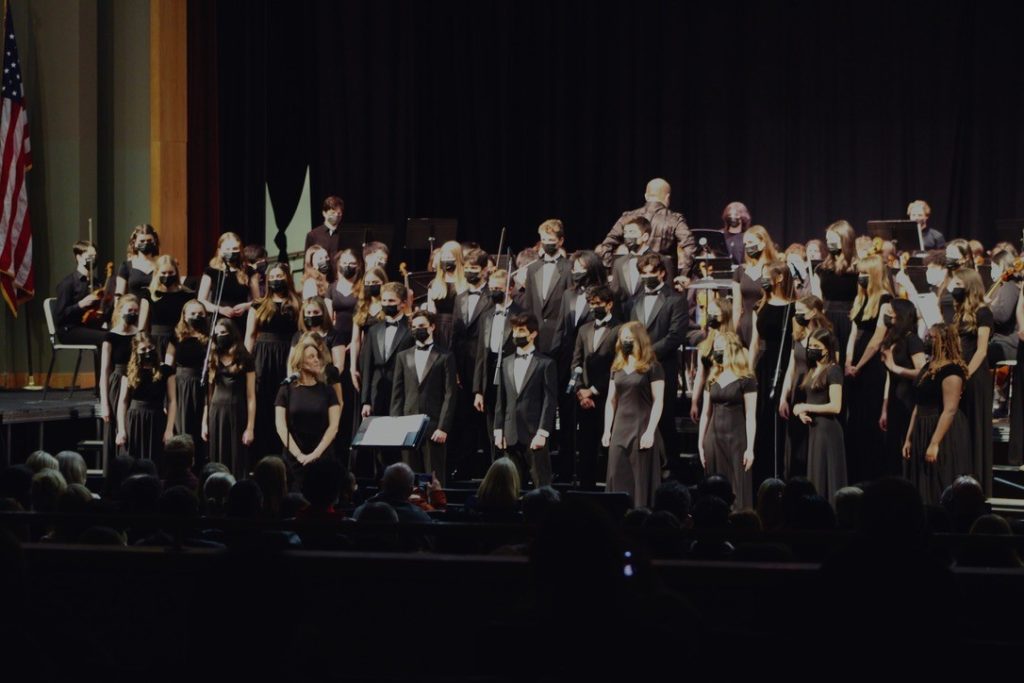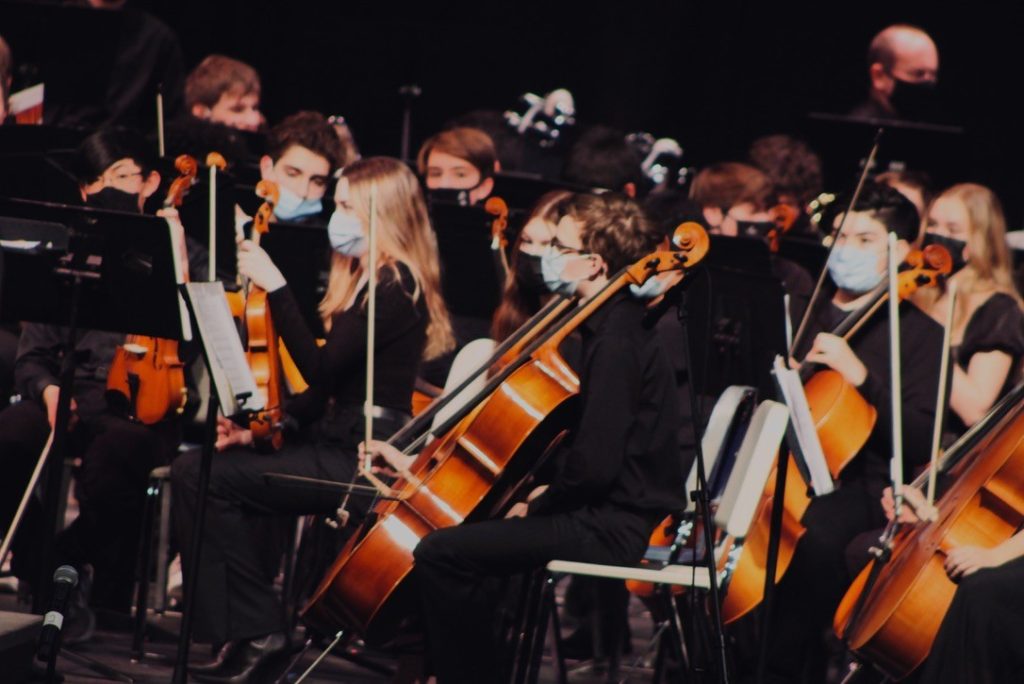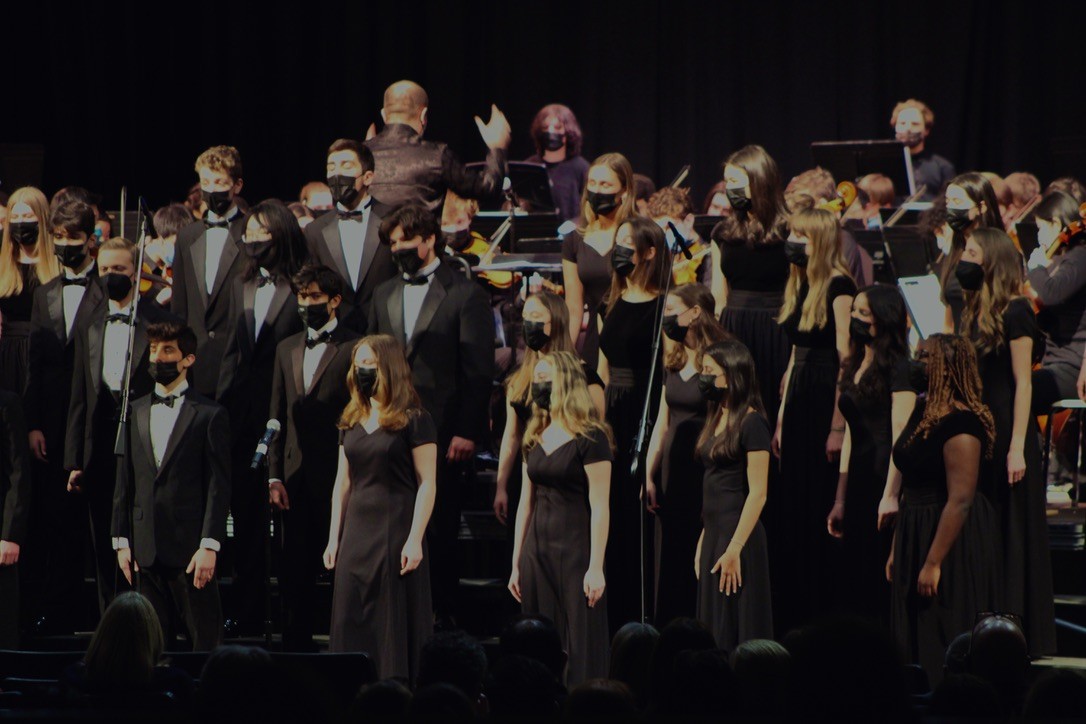Luke Huang, Reporter
@lukehcourant
Audience members find themselves holding their breaths while they focus on the conductor’s raised baton, poised to fall with a force of more than a hundred choral, string, and band musicians. Perspiration begins to condense on a few of the student’s foreheads, as the heat from the bracing stage light is absorbed into their black clothes. With a flick of the wrist, the high school Collaborative Concert begins.

The collaborative concert is an annual performance that combines the band, choral, and orchestral programs. This year’s collaborative concert took place on Tuesday, February 8th at 7 pm in the auditorium. It is the first one since the pandemic hit nearly two years ago.
Last year, the pandemic forced the music departments at our town’s public schools to adapt to online learning policies. The band, choir, and orchestra are all intrinsically collaborative activities, and Covid regulations have disrupted that collaborative aspect.
Scott Cranston, the band director, said that band musicians at Saxe did not play their instruments at all last year, while high school students missed half of the year. “I feel because we lost that time during the remote learning, we’re still trying to gain that back. We will get it back, but it’s just going to take time,” Leo Ficks, the orchestra director, said.
Hybrid scheduling and remote learning also meant that there were no regular rehearsals. “Being at home and zooming last year was not a good thing,” said Sarah Gleason, the choral director. “We were lucky enough to keep singing last year, but until spring last year, we never had the full choir together.”
After experiencing remote learning, student musicians and music directors were looking forward to performing together. “We missed the sounds. You just can’t replicate it on your own”, Ms. Gleason said.

Michael Caldero, junior and band musician, said that “I miss all the people that used to come. I look forward to having more people come by to see our concerts.”
Live performances by the choir, band, and orchestra only started again during the fall of this school year, with limited audience members and covid-regulations in place. According to Mr. Cranston, the excitement was high. Anav Sahay, a sophomore trumpeter, said “I’m looking forward to this. We’ve been working on this music for a while now, and all the pieces are awesome. Even better, we get to play with the orchestra and the chorus as well.”
During rehearsals, the choir, band, and orchestra faced difficulties with synchronizing. Conducting one of the three music groups is already a difficult task, according to Mr. Ficks. The collaborative concert was a challenge that required dedication from the all three music directors and more than a hundred student musicians.
In all music departments, practice and rehearsals are the most critical part of learning and improving. “When the band is together for a rehearsal, that would be the equivalent of a scrimmage on a sports team,” Mr. Cranston said. When a football team gets ready to go, they’re going to scrimmage each other to see how their plays work in an overall context. That’s what rehearsals do: it shows how everything fits in an overall context.”

In those rehearsals, it is a challenge in collaboration and communication to coordinate the dozens of musicians. “When we are playing, we tend to be very busy, we are playing our individual part but this is a team sport and the coordination of all the musicians is very challenging,” Mr. Ficks said. “It involves listening, it involves watching the conductor, and inevitably making adjustments.”
In the choir, the same skills are needed. “Learning to create music with others takes focus, patience, collaboration, resilience because it’s hard for everyone to get it right at the same time. It’s difficult for all those things to come together, but there’s so much to be gained from it. There are a lot more skills needed than just beautiful singing,” Ms. Gleason said.
Furthermore, musicians need to play completely in sync with each other. “The bottom line is we only play as well as our weakest link. In music, if you have accuracy happening across most people and then one person plays a wrong note or rhythm, the music doesn’t align. That mistake is what the audience hears,” Mr. Cranston said.
The individual initiatives of the student musicians are also an important part of rehearsals. “We’re trying to have excellence come from all levels and with leadership from the upperclassmen,” Mr. Cranston said. According to Mr. Ficks, leadership usually comes with experience, and those leaders help lead various sections of the orchestra.
In the collaborative concert, the challenges of coordination and collaboration are intensified. “The thing that makes it difficult is the number of them versus the number of us. There are like a hundred of them and two of us,” Mr. Cranston said. “I’ll be in the center of the stage conducting the band and orchestra with seventy people. Ms. Gleason has another thirty-seven choir students in the front.”

The lack of regular rehearsals among the choir, band, and orchestra has made the collaborative concert a unique test of coordination. “It’s interesting that we don’t have a lot of time to put the different ensembles together, so everyone needs to make sure they know exactly what they’re doing,” Ms. Gleason said.
“After rehearsal yesterday, it occurred that the big challenge is that we don’t get together to rehearse as a band and orchestra usually. If we had that, the challenge with coordination would be a lot less,” Mr. Ficks added.
The music directors believe that a collaborative concert like this is more important now than ever. “It is a pure joy to watch a hundred students doing the same thing at the same time without the use or enhancement or convenience of technology. It is real. It’s the kind of joy that people should be thinking about in their lives,” Mr. Cranston said.
“You don’t often get to see this all in one night, from that many students,” Ms. Gleason said. “I think it’s a real treat for the community to see a little of what all three music departments are doing.”




